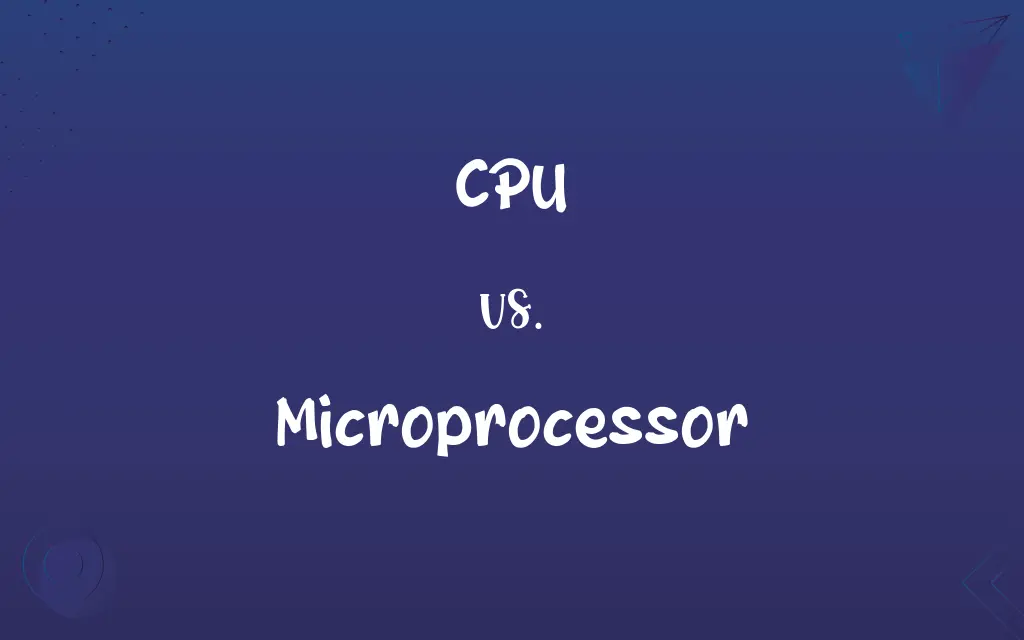CPU vs. Microprocessor: Know the Difference

By Shumaila Saeed || Published on October 3, 2024
A CPU (Central Processing Unit) is the primary component of a computer that executes instructions, while a microprocessor is a single integrated circuit that contains a CPU and often other functionalities.

Key Differences
CPU (Central Processing Unit) and Microprocessor both relate to computing, but the CPU refers specifically to the primary computing unit that processes instructions, whereas a microprocessor encompasses a CPU and integrates additional features like memory and input/output controls on a single chip.
Shumaila Saeed
Oct 03, 2024
While a CPU is essentially the brain of a computer, executing instructions and managing data, a Microprocessor represents a more comprehensive solution, combining the CPU with other essential components, making it a self-contained processing unit.
Shumaila Saeed
Oct 03, 2024
The CPU is integral to computing, functioning as the core element that interprets and executes software instructions, whereas the Microprocessor not only includes a CPU but also integrates other functionalities, offering a more complete processing solution.
Shumaila Saeed
Oct 03, 2024
In terms of architecture, a CPU is focused purely on processing capabilities, handling complex calculations and data management, while a Microprocessor extends beyond this, integrating additional features like memory management and peripheral interfacing on a single chip.
Shumaila Saeed
Oct 03, 2024
Historically, the CPU was a distinct component within computers, handling all the primary processing tasks, but the advent of the Microprocessor marked a shift towards integrating multiple functions, including the CPU, into a single, more efficient unit.
Shumaila Saeed
Oct 03, 2024
ADVERTISEMENT
Comparison Chart
Definition
The core component of a computer that executes instructions
A single integrated circuit containing a CPU and additional functionalities
Shumaila Saeed
Oct 03, 2024
Primary Function
Executes software instructions and manages data
Integrates CPU functions with memory, I/O controls, and sometimes graphics processing
Shumaila Saeed
Oct 03, 2024
Presence in Devices
Found in all computing devices as a standalone or part of a chip
Used in a wide range of devices, including computers, smartphones, and embedded systems
Shumaila Saeed
Oct 03, 2024
Complexity
Focused on processing capabilities
Combines processing with other elements for a comprehensive solution
Shumaila Saeed
Oct 03, 2024
Historical Context
Predates microprocessors as the main computing element
Evolved to incorporate CPUs and other components for efficiency
Shumaila Saeed
Oct 03, 2024
ADVERTISEMENT
CPU and Microprocessor Definitions
CPU
The CPU is the core component in a computer that processes instructions.
The CPU quickly processed the complex algorithm, enhancing the computer's performance.
Shumaila Saeed
Jan 15, 2024
Microprocessor
Microprocessors offer a compact solution for complex computing in various devices.
The drone's microprocessor enabled it to stabilize in flight and capture high-quality images.
Shumaila Saeed
Jan 15, 2024
CPU
A CPU translates user inputs into machine-readable instructions.
The faster CPU significantly reduced the time for data analysis.
Shumaila Saeed
Jan 15, 2024
Microprocessor
A microprocessor encompasses the functions of a CPU along with additional features.
The embedded microprocessor in the thermostat efficiently regulated the home's temperature.
Shumaila Saeed
Jan 15, 2024
CPU
A CPU serves as the brain of a computer, executing software commands.
Upgrading the CPU improved the laptop's ability to multitask efficiently.
Shumaila Saeed
Jan 15, 2024
ADVERTISEMENT
Microprocessor
A microprocessor acts as the central unit in modern electronics, handling multiple tasks.
The car's microprocessor controlled its navigation and entertainment systems.
Shumaila Saeed
Jan 15, 2024
CPU
The CPU interprets and carries out the basic instructions that operate a computer.
The game's graphics required a powerful CPU to run smoothly.
Shumaila Saeed
Jan 15, 2024
Microprocessor
A microprocessor is an integrated circuit that contains a CPU and other functionalities.
The smartphone's microprocessor managed both processing and memory tasks.
Shumaila Saeed
Jan 15, 2024
CPU
CPUs are essential for executing programs and managing the system's operations.
The server's CPU handled thousands of requests per second.
Shumaila Saeed
Jan 15, 2024
Microprocessor
Microprocessors integrate computing power and control functions in one chip.
The microprocessor in the washing machine controls both the motor and the user interface.
Shumaila Saeed
Jan 15, 2024
CPU
The central processing unit, that part of the electronic circuitry of a computer in which the arithmetic and logical operations are performed on input data, which are thereby converted to output data; it is usually located on the mainboard, or motherboard, of a computer. The CPU and the memory form the central part of a computer to which the peripherals are attached. Most personal computers as of 1998 had only one CPU, but some computers may have more than one CPU.
Shumaila Saeed
Jan 14, 2024
Microprocessor
An integrated circuit that contains a major processing unit of a computer on a single microchip, such as the central processor or the graphics processor.
Shumaila Saeed
Jan 14, 2024
CPU
(computer science) the part of a computer (a microprocessor chip) that does most of the data processing; the CPU and the memory form the central part of a computer to which the peripherals are attached
Shumaila Saeed
Jan 14, 2024
Microprocessor
(computer hardware) the entire CPU of a computer on a single integrated circuit (chip).
Shumaila Saeed
Jan 14, 2024
Microprocessor
Integrated circuit semiconductor chip that performs the bulk of the processing and controls the parts of a system;
A microprocessor functions as the central processing unit of a microcomputer
A disk drive contains a microprocessor to handle the internal functions of the drive
Shumaila Saeed
Jan 14, 2024
Repeatedly Asked Queries
Are CPUs and microprocessors interchangeable terms?
Not exactly. While a CPU is the core of computing power, a microprocessor is a broader term that includes a CPU and other integrated features.
Shumaila Saeed
Oct 03, 2024
Do smartphones have microprocessors?
Yes, smartphones contain microprocessors that handle processing, memory, and other controls.
Shumaila Saeed
Oct 03, 2024
What does a microprocessor do?
A microprocessor integrates a CPU with other functionalities like memory and I/O controls on a single chip.
Shumaila Saeed
Oct 03, 2024
How does a CPU impact computer performance?
The CPU's speed and efficiency directly influence the computer's ability to process data and run programs.
Shumaila Saeed
Oct 03, 2024
Can a microprocessor work without a CPU?
No, the CPU is an essential part of a microprocessor, responsible for executing instructions.
Shumaila Saeed
Oct 03, 2024
Is upgrading a CPU the same as upgrading a microprocessor?
Upgrading a CPU in isolation enhances processing power, whereas upgrading a microprocessor can improve overall system functionality.
Shumaila Saeed
Oct 03, 2024
What is a CPU?
The CPU, or Central Processing Unit, is the primary component in computers that processes instructions.
Shumaila Saeed
Oct 03, 2024
Can a device have a CPU without a microprocessor?
No, a CPU is a part of a microprocessor; it can be a standalone component or integrated within a microprocessor.
Shumaila Saeed
Oct 03, 2024
How has microprocessor technology evolved?
Microprocessor technology has evolved to integrate more features like graphics processing and energy efficiency into a single chip.
Shumaila Saeed
Oct 03, 2024
What is the difference in functionality between a CPU and a microprocessor?
The CPU specifically handles processing tasks, while a microprocessor combines processing with other computing functions.
Shumaila Saeed
Oct 03, 2024
What factors determine the performance of a CPU?
CPU performance is determined by factors like clock speed, core count, and architecture.
Shumaila Saeed
Oct 03, 2024
Can the functions of a CPU and microprocessor overlap?
Yes, the functions can overlap as the CPU is a part of the microprocessor, handling the core processing tasks.
Shumaila Saeed
Oct 03, 2024
Why is a microprocessor important in embedded systems?
In embedded systems, a microprocessor provides compact and efficient control and processing capabilities.
Shumaila Saeed
Oct 03, 2024
How do CPUs and microprocessors impact energy consumption?
Both CPUs and microprocessors impact energy consumption, with newer models designed for greater energy efficiency and lower power usage.
Shumaila Saeed
Oct 03, 2024
Are microprocessors used in appliances other than computers?
Yes, microprocessors are used in a wide range of devices like smartphones, cars, and home appliances.
Shumaila Saeed
Oct 03, 2024
What is the significance of a CPU in a server?
In servers, the CPU plays a critical role in handling large volumes of data and managing multiple simultaneous tasks.
Shumaila Saeed
Oct 03, 2024
How do microprocessors contribute to mobile technology?
Microprocessors in mobile devices enable compact and efficient processing, allowing for advanced features and connectivity.
Shumaila Saeed
Oct 03, 2024
What advancements have been made in CPU technology?
Advancements in CPU technology include increased core counts, higher clock speeds, and more efficient architectures.
Shumaila Saeed
Oct 03, 2024
What role does a CPU play in gaming computers?
In gaming computers, the CPU is crucial for running the game software and managing real-time data processing.
Shumaila Saeed
Oct 03, 2024
Can a computer have multiple CPUs or microprocessors?
Yes, some high-performance computers and servers have multiple CPUs or microprocessors for enhanced processing power and multitasking capabilities.
Shumaila Saeed
Oct 03, 2024
Share this page
Link for your blog / website
HTML
Link to share via messenger
About Author
Written by
Shumaila SaeedShumaila Saeed, an expert content creator with 6 years of experience, specializes in distilling complex topics into easily digestible comparisons, shining a light on the nuances that both inform and educate readers with clarity and accuracy.








































































